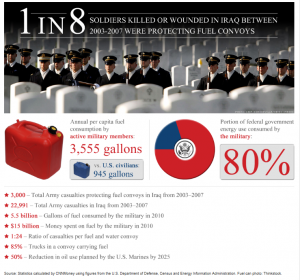 GridWeek 2012 convened earlier this month in Washington D.C., and as a first time attendee, I left breathless and hopeful – yet confused – by inexplicable lingering complacency. Unbeknownst to me, by agreeing to be a panelist in two sessions, I was setting up a comparative experiment. For the first panel, I spoke on “New Utility Business Models” to a packed room of the glimmer-eyed new energy intelligentsia, which is what makes GridWeek so exciting. In the later days of the conference, about a dozen GridWeek participants interspersed amongst a room of mostly empty seats to hear my panel presentation on “Smart Grid’s Role in New Air Quality Standards.”
GridWeek 2012 convened earlier this month in Washington D.C., and as a first time attendee, I left breathless and hopeful – yet confused – by inexplicable lingering complacency. Unbeknownst to me, by agreeing to be a panelist in two sessions, I was setting up a comparative experiment. For the first panel, I spoke on “New Utility Business Models” to a packed room of the glimmer-eyed new energy intelligentsia, which is what makes GridWeek so exciting. In the later days of the conference, about a dozen GridWeek participants interspersed amongst a room of mostly empty seats to hear my panel presentation on “Smart Grid’s Role in New Air Quality Standards.”
It would seem that I, and the handful of attendees at the air quality panel, see the productive overlaps between air quality standards compliance, smart grid and new utility revenues. There are several ways that smart grid provides a value proposition for utilities faced with increasingly stringent air quality regulations, most recently the Mercury and Air Toxics Standards (MATS) rule. Here’s a short, but by no means comprehensive, list of both synergies and potential tensions:
- Renewable Portfolio Standards (RPS): Smart grid supports achieving higher and higher proportions of intermittent, non-dispatchable renewable electricity generation. Achieving high levels of RPS will be expensive unless we can use new strategies to manage intermittency and power quality. New pricing structures for utility services can provide incentives to invest on both sides of the meter, and open the door for historically hidden utility services (such as voltage regulation) to be priced and sold. For incumbent utilities, there is an opportunity to identify and price network services that traditionally have been bundled into rates.
- Electric Vehicles (EV): EVs are an important new frontier for utilities, and like most frontiers, offer both promise and peril. Overloaded distribution networks might keep the utility engineers up at night, while the emerging new customer class has utility shareholders thinking like venture capitalists. Though still small in number, EVs are quickly driving utility planners and system operators toward a fork in the road. Do we provide safe reliable service to new and existing customers using expensive dirty methods of the past (i.e., more big power plants) or do we take a deep breath (of cleaner air) and trust in the power of the people by embracing distributed energy resources?
- Distributed Energy Resources (DER): Rooftop solar, energy efficiency, and demand response, collectively known as distributed energy resources, unquestionably can provide the low cost, clean pathway towards both energy independence and a sustainable economy. However, DER is harder to plan and dispatch, and it threatens the traditional utility business models of incumbent institutions. In California, net energy metering policy has been an important ignition switch, fueled by the California Solar Roofs Initiative, but these successful policies need to evolve to achieve DER at larger scales. Again, the key is precisely pricing the goods and services on both sides of the meter. Utilities should be paid for power quality and storage services provided to owners of rooftop systems, while electricity from those rooftops should be priced fairly to provide incentive to invest.
- Clean air standards: Oxides of nitrogen, particulate matter, acidifying compounds and carcinogens, such as mercury, are the power sector’s long-time emissions concerns. Across the nation, electricity generators must hold permits to pollute and tradable emissions allowances that must be acquired at nontrivial prices. Starting in 2013, California electricity generation that emits global warming pollution will have an associated cost –carbon allowances in the state’s cap-and-trade program. Already, polluters in Southern California must acquire emissions allowances for the RECLAIM program, and power plants nationwide must comply with the acid rain emissions allowance program established in the Federal Clean Air Act . Similarly, the Regional Greenhouse Gas Initiative (RGGI) program puts a price on carbon emissions for nine northeastern states, and the Western Climate Initiative is endeavoring to do the same for West Coast states and Canadian provinces. These programs use emissions allowances that are fungible and tradable, yet they represent real costs – and thus economic opportunity when avoided. Pollution pricing is changing business models throughout North America. But there is more to come. For example, improved environmental performance enabled by smart grid technologies, such as increasing DER, presents new avenues to meet air quality requirements. For the Environmental Protection Agency (EPA) and other oversight agencies, the ability to measure, verify and enforce DER is key to granting compliance credit, and such capabilities are increasingly cost-effective with smart grid deployment.
- Consumer empowerment: The mobile phone revolution is a prelude to what may be possible once consumers and producers begin to see true pricing in the energy marketplace. While load-serving entities can find new revenues through services, consumers and entrepreneurs will be motivated by new ways to make a buck, or avoid spending bucks through unnecessary energy waste.
The new smart grid business frontier has, in fact, many frontiers. The California Public Utilities Commission conceived of an electricity ecosystem comprised of smart consumers, smart markets and smart utilities. Utilities are trying to find their new niche within the ever changing food web, and all ears are perked for new opportunities. That’s why only standing room was available in the business model panel session at Gridweek.
Meanwhile, in the air quality session of GridWeek, there was plenty of elbow room.EPA is considering flexible strategies for meeting new emissions standards for carcinogens. Many utilities are operating in permit constrained areas that fail to meet National Ambient Air Quality Standards. Enlightened utilities are seeing demand-side strategies as increasingly viable with smart meter deployment, and a means to improve returns to shareholders. Performance-based rate of return can be structured to both reduce sales of energy to customer and to improve utility earnings.
Gridweek revealed to me that many are educating themselves about new business opportunities, but precious few have the connected the dots to air quality improvements. If I could, I’d bet on the folks who attended both sessions.
















 Update: Please note that the EPA is now due to finalize the national emission standards for oil and gas activities by Tuesday, April 17.
Update: Please note that the EPA is now due to finalize the national emission standards for oil and gas activities by Tuesday, April 17.